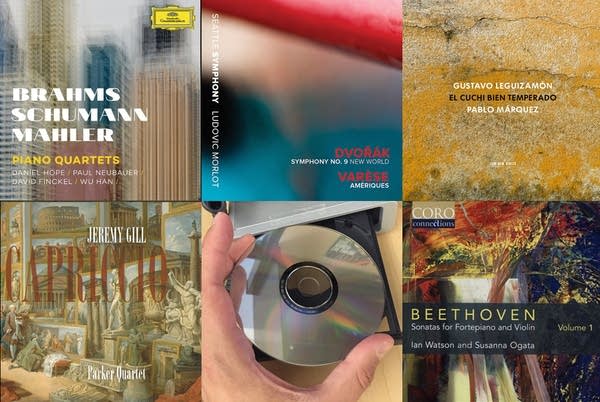A new "New World," Beethoven for fortepiano, a fanciful quartet, essential Argentinian music, and the latest from David Finckel and Wu Han: Terry Blain writes about five of this month's most exciting new classical music releases.
Dvorak, "New World" Symphony; Varèse, Amériques
A little over 20 years separated the arrival in New York City of the Czech composer Antonín Dvořák and that of his French counterpart Edgar Varèse. The works they wrote about America, rarely paired on disc, show how startlingly the country had changed in two decades, powered forward by the dizzying pace of technological and industrial innovation. Varèse's Amériques is a squealing cityscape—his orchestra includes a siren—drenched with the grindingly metallic rhythms of a modern metropolis in 24/7 operation. Dvorák's "New World" Symphony, by contrast, harks nostalgically back to an era where the zoned-out contemplation of the famous "Largo" was still possible, amid the teeming energies located in the outer movements. The Seattle Symphony plays both pieces with an incisive dynamism typical of its work under music director Ludovic Morlot, and its own-label recording is full of visceral impact.
(Seattle Symphony Media SSM1006)
Beethoven, Sonatas for Fortepiano and Violin (Volume 1)
Listening to this performance of Beethoven's towering "Kreutzer" Sonata, you fear for the fortepiano Ian Watson is playing. It's a copy of the Anton Walter piano Beethoven himself owned and played on, and you get a much more potent sense of how close Beethoven came to bursting the boundaries of what the instrument was capable of, than you do on a larger modern grand piano. The opening movement crackles with the interplay between Watson and the Boston-based violinist Susanna Ogata, who also plays an instrument of Beethoven's period. Hers is a lean, sinewy sound, enabling Beethoven's sharp, rebarbative rhythms to fully register, and overall there is a sense of edginess and daring about these interpretations (Sonata 4 is also included) which makes the music sound fresh-minted and highly innovative. A powerful opening salvo in a promised series of all ten Beethoven violin sonatas.
Jeremy Gill, Capriccio
"Capriccio: a humorous, fanciful or bizarre composition." As a basic definition that's acceptable, but it doesn't do justice to what American composer Jeremy Gill has achieved in his hour-long piece of that title. His aim, initially, was to construct a sequence of short, educationally useful movements illustrating various techniques and strategies used by string players and those who write for them. The story, however, grew in the telling, and Gill ended up with 27 sections—with titles like "Tip, balance, frog; wood" and "Pluck, snap"—which, heard uninterrupted, make a compelling musical narrative much greater than the sum of the individual parts. Gill's stylistic references range from retro-Baroque to plinkingly post-modern, and the performance by the Parker Quartet, who commissioned the piece, is stunningly accomplished. A work to return to often, for fresh insight and stimulation.
Gustavo Leguizamón, El Cuchi Bien Temperado
Gustavo Leguizamón—affectionately dubbed "Cuchi" ("Pig") in his hometown of Salta—was one of the most influential Argentinian musicians of the twentieth century. His most enduring contribution was probably the numerous folk dance "zambas" that he wrote, many of which passed into popular culture. Guitarist Pablo Márquez has fashioned from these a collection of 17 pieces, aiming to catch the essence of Leguizamón as musical creator. "Cuchi" was a classically literate composer, studying the works of Debussy, Ravel, Stravinsky and Schoenberg to keep abreast of contemporary music in his period. Some of their influence seeps into his zambas, which have a harmonic and textural intricacy belying their raw folkloric origins. Márquez's performances are beautifully voiced, catching adeptly the mix of "erudita y popular"—high culture and vernacular—which gives Leguizamón's music its particular flavor.
Brahms, Schumann, Mahler Piano Quartets
When cellist David Finckel left a safe seat in the Emerson Quartet, one of the world's finest, two seasons ago, it was probably the attraction of projects like this one that made him do it. Over two evenings in March of this year, at Lincoln Center, Finckel and his pianist wife Wu Han were joined by violinist Daniel Hope and violist Paul Neubauer to make these live recordings. Together they bring a welcome lilt and lightness of texture to the opening movement of Brahms's G minor Quartet, and the Andante has both sweet lyricism and a pleasing sense of flow to the phrasing. Wu Han's deftness in the "Gypsy Rondo" keeps the music buoyant, though the slightly dry acoustic causes a degree of coarseness in the frantic finale. The Schumann and Mahler pieces are equally refreshing, lightly sprung, and generously expressive.
(Deutsche Grammophon B0022906-02)
Terry Blain was educated in Northern Ireland and Cambridge, England, and writes for a wide range of publications, including BBC Music Magazine and Opera Magazine. In his spare time he is an avid record collector, and walks his dog Buddy.
Love the music?
Show your support by making a gift to YourClassical.
Each day, we’re here for you with thoughtful streams that set the tone for your day – not to mention the stories and programs that inspire you to new discovery and help you explore the music you love.
YourClassical is available for free, because we are listener-supported public media. Take a moment to make your gift today.


